Report on Structures and Functions of the Digestive System in Biology
VerifiedAdded on 2023/05/27
|10
|841
|93
Report
AI Summary
This report provides a comprehensive overview of the human digestive system, detailing the structures and functions of each component. It begins with the mouth, tracing the path of food through the pharynx, esophagus, stomach, small and large intestines, and rectum. The report explains the roles of the pancreas, liver, and gallbladder in digestion. It differentiates between chemical and mechanical digestion, highlighting the enzymes and processes involved. It also examines the optimal conditions for enzymatic action, including pH and temperature, and concludes with a discussion of the constituent food groups of a balanced diet, including carbohydrates, fats, proteins, vitamins, and minerals. The report draws on research from sources such as Kong and Singh (2008) and the British Nutrition Foundation, providing a solid foundation for understanding the digestive process.
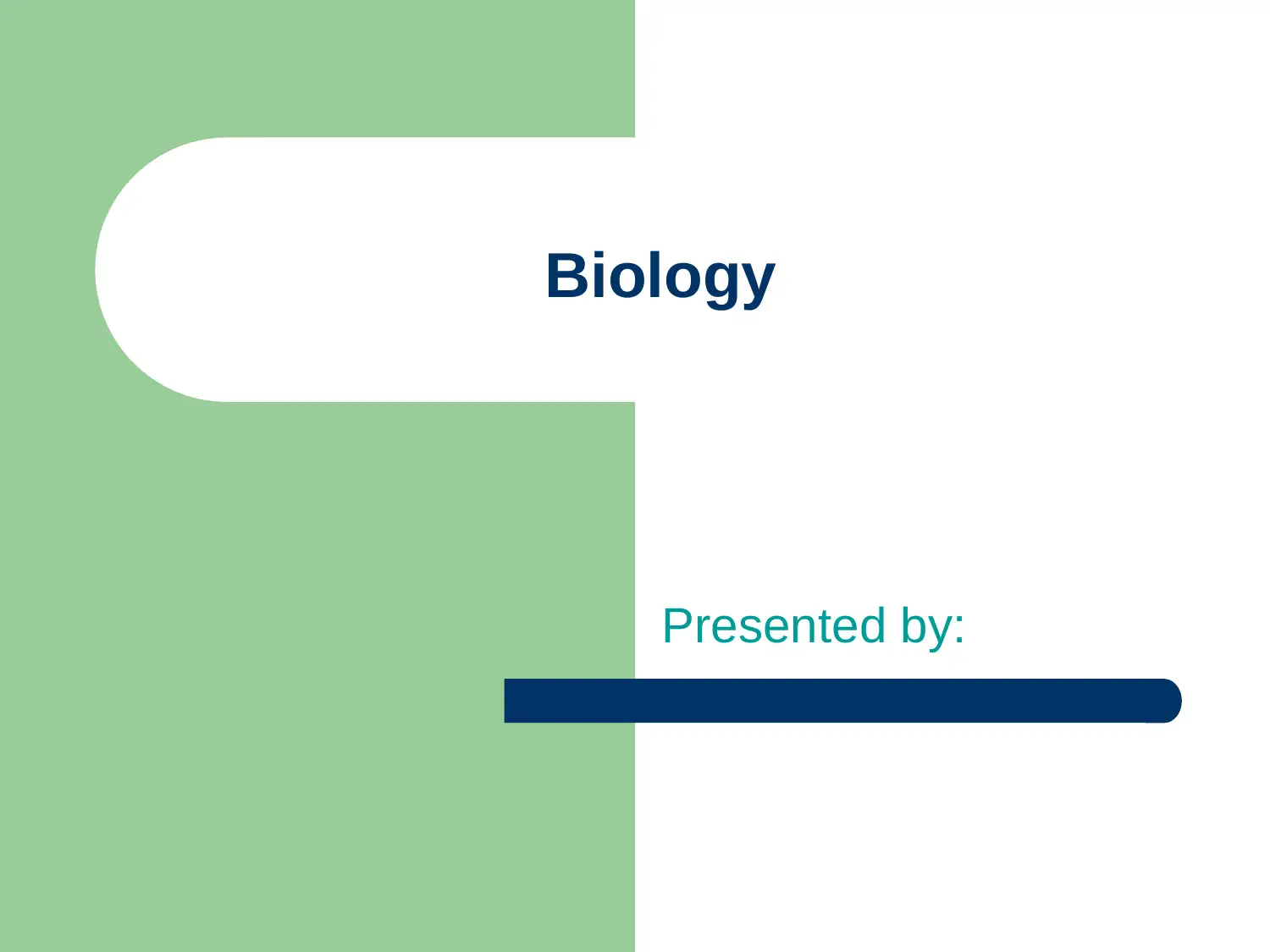
Biology
Presented by:
Presented by:
Paraphrase This Document
Need a fresh take? Get an instant paraphrase of this document with our AI Paraphraser

Structures and Functions of the
Digestive System
Mouth
– Ingests food
– Chemical analysis of
carbohydrates
– Initiates the breakdown of
lipids through lingual lipase
– Food is moved to the pharynx
Pharynx
– Pushes food from the mouth
to the oesophagus (Kong and
Singh, 2008).
Digestive System
Mouth
– Ingests food
– Chemical analysis of
carbohydrates
– Initiates the breakdown of
lipids through lingual lipase
– Food is moved to the pharynx
Pharynx
– Pushes food from the mouth
to the oesophagus (Kong and
Singh, 2008).
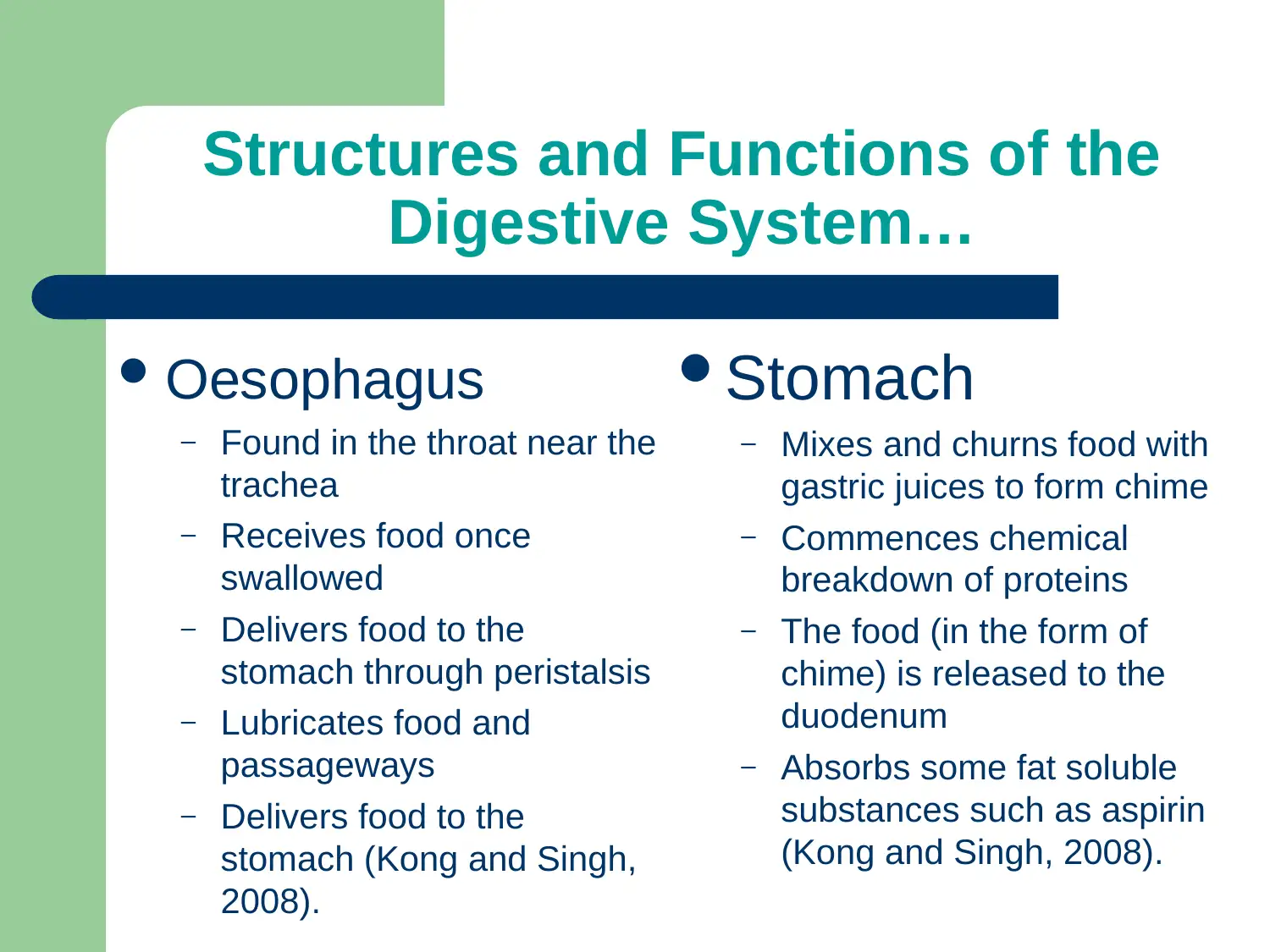
Structures and Functions of the
Digestive System…
Stomach
– Mixes and churns food with
gastric juices to form chime
– Commences chemical
breakdown of proteins
– The food (in the form of
chime) is released to the
duodenum
– Absorbs some fat soluble
substances such as aspirin
(Kong and Singh, 2008).
Oesophagus
– Found in the throat near the
trachea
– Receives food once
swallowed
– Delivers food to the
stomach through peristalsis
– Lubricates food and
passageways
– Delivers food to the
stomach (Kong and Singh,
2008).
Digestive System…
Stomach
– Mixes and churns food with
gastric juices to form chime
– Commences chemical
breakdown of proteins
– The food (in the form of
chime) is released to the
duodenum
– Absorbs some fat soluble
substances such as aspirin
(Kong and Singh, 2008).
Oesophagus
– Found in the throat near the
trachea
– Receives food once
swallowed
– Delivers food to the
stomach through peristalsis
– Lubricates food and
passageways
– Delivers food to the
stomach (Kong and Singh,
2008).
⊘ This is a preview!⊘
Do you want full access?
Subscribe today to unlock all pages.

Trusted by 1+ million students worldwide
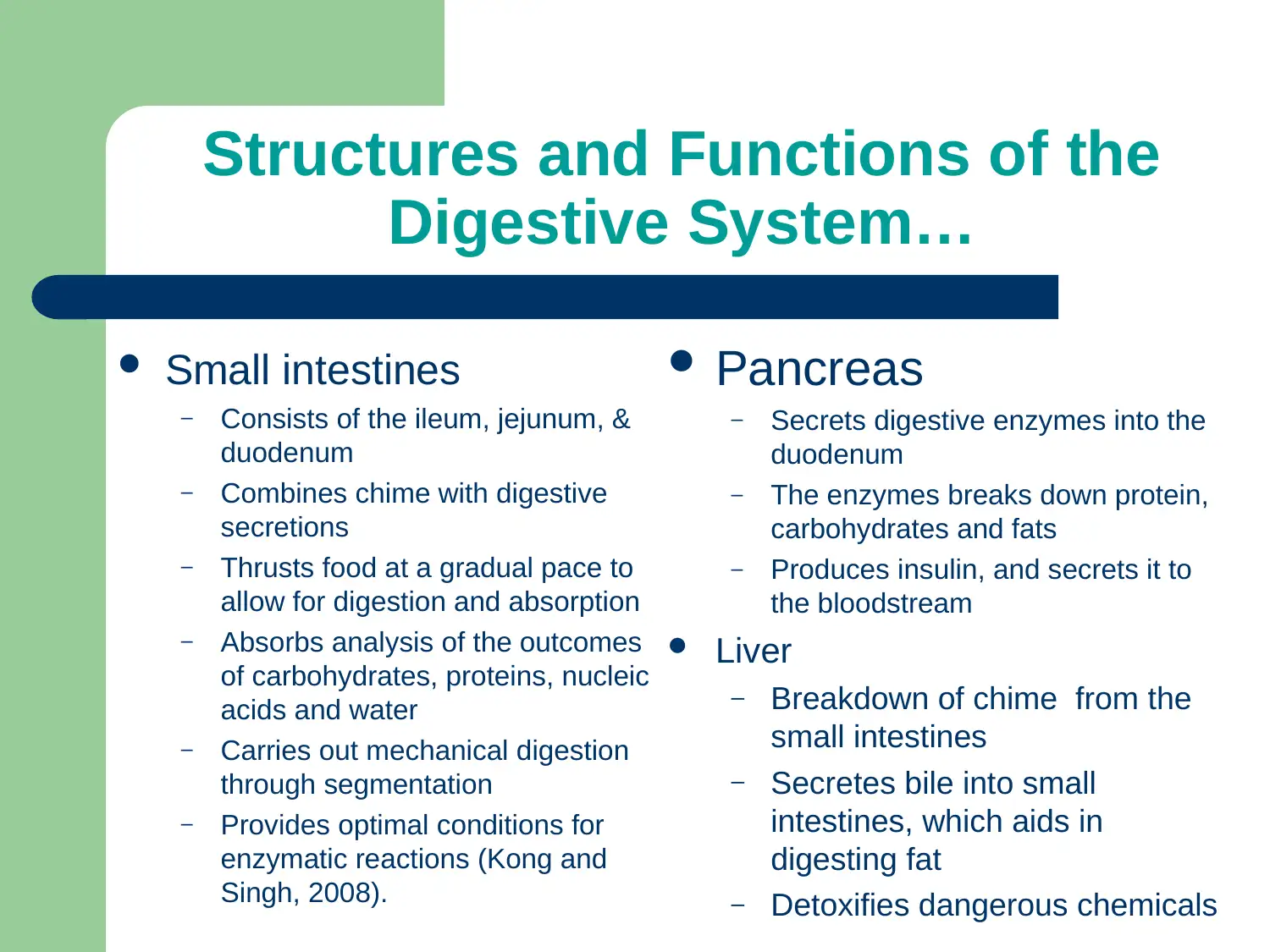
Structures and Functions of the
Digestive System…
Pancreas
– Secrets digestive enzymes into the
duodenum
– The enzymes breaks down protein,
carbohydrates and fats
– Produces insulin, and secrets it to
the bloodstream
Liver
– Breakdown of chime from the
small intestines
– Secretes bile into small
intestines, which aids in
digesting fat
– Detoxifies dangerous chemicals
Small intestines
– Consists of the ileum, jejunum, &
duodenum
– Combines chime with digestive
secretions
– Thrusts food at a gradual pace to
allow for digestion and absorption
– Absorbs analysis of the outcomes
of carbohydrates, proteins, nucleic
acids and water
– Carries out mechanical digestion
through segmentation
– Provides optimal conditions for
enzymatic reactions (Kong and
Singh, 2008).
Digestive System…
Pancreas
– Secrets digestive enzymes into the
duodenum
– The enzymes breaks down protein,
carbohydrates and fats
– Produces insulin, and secrets it to
the bloodstream
Liver
– Breakdown of chime from the
small intestines
– Secretes bile into small
intestines, which aids in
digesting fat
– Detoxifies dangerous chemicals
Small intestines
– Consists of the ileum, jejunum, &
duodenum
– Combines chime with digestive
secretions
– Thrusts food at a gradual pace to
allow for digestion and absorption
– Absorbs analysis of the outcomes
of carbohydrates, proteins, nucleic
acids and water
– Carries out mechanical digestion
through segmentation
– Provides optimal conditions for
enzymatic reactions (Kong and
Singh, 2008).
Paraphrase This Document
Need a fresh take? Get an instant paraphrase of this document with our AI Paraphraser
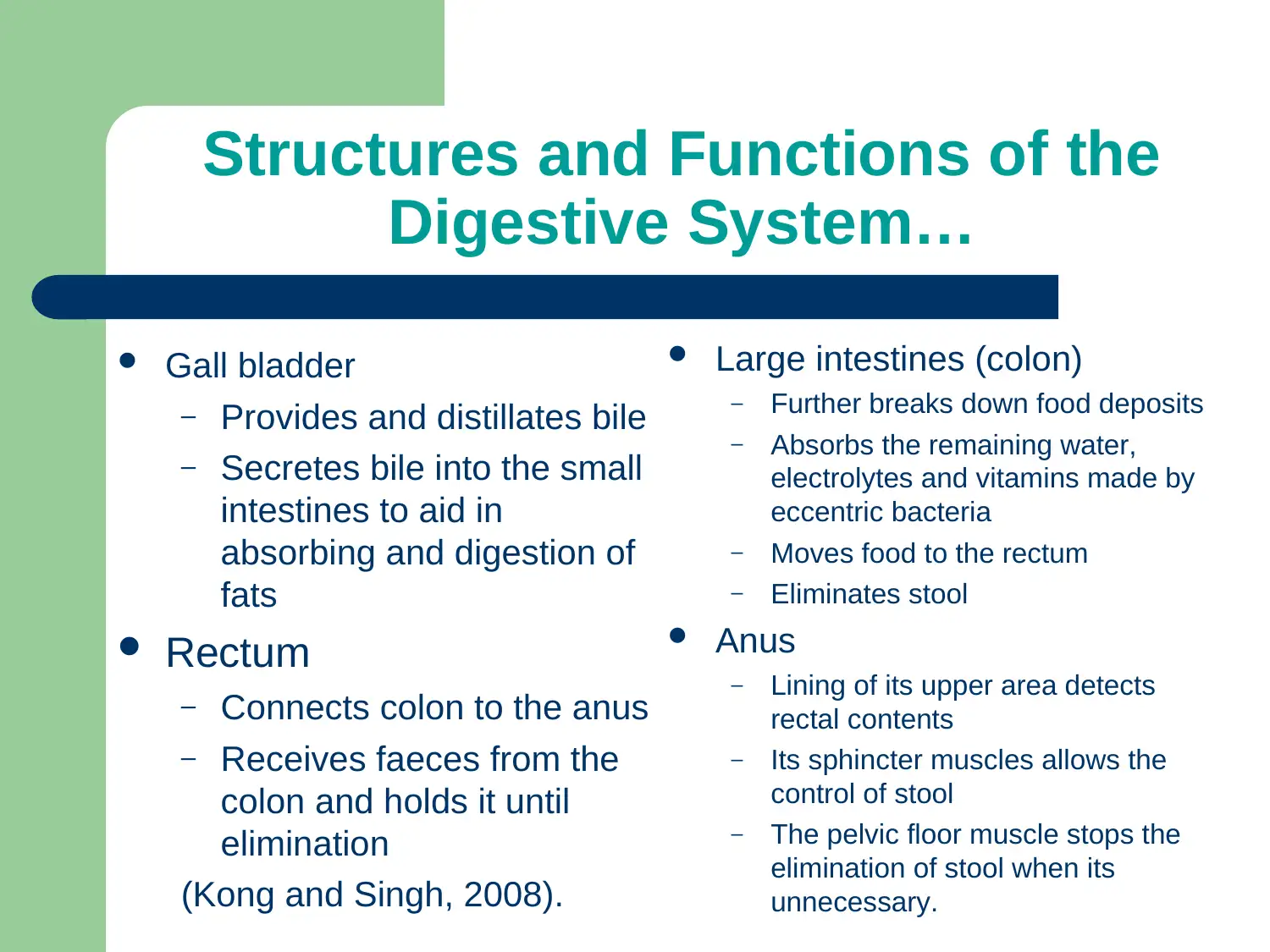
Structures and Functions of the
Digestive System…
Large intestines (colon)
– Further breaks down food deposits
– Absorbs the remaining water,
electrolytes and vitamins made by
eccentric bacteria
– Moves food to the rectum
– Eliminates stool
Anus
– Lining of its upper area detects
rectal contents
– Its sphincter muscles allows the
control of stool
– The pelvic floor muscle stops the
elimination of stool when its
unnecessary.
Gall bladder
– Provides and distillates bile
– Secretes bile into the small
intestines to aid in
absorbing and digestion of
fats
Rectum
– Connects colon to the anus
– Receives faeces from the
colon and holds it until
elimination
(Kong and Singh, 2008).
Digestive System…
Large intestines (colon)
– Further breaks down food deposits
– Absorbs the remaining water,
electrolytes and vitamins made by
eccentric bacteria
– Moves food to the rectum
– Eliminates stool
Anus
– Lining of its upper area detects
rectal contents
– Its sphincter muscles allows the
control of stool
– The pelvic floor muscle stops the
elimination of stool when its
unnecessary.
Gall bladder
– Provides and distillates bile
– Secretes bile into the small
intestines to aid in
absorbing and digestion of
fats
Rectum
– Connects colon to the anus
– Receives faeces from the
colon and holds it until
elimination
(Kong and Singh, 2008).

Chemical Digestion
Involves enzyme secretion throughout the whole
digestive tract
Chemical digestion is responsible for the breakdown of
various nutrients such as carbohydrates into much
smaller parts.
Begins in the mouth, where salivary glands secrete saliva
into the mouth.
Digestive enzymes in the mouth:
– Salivary amylase – breaks down polysaccharides
Digestive enzymes in the small intestines:
– Lactase - digests lactose (Bakke, Glover,and
Krogdahl, 2010)
Involves enzyme secretion throughout the whole
digestive tract
Chemical digestion is responsible for the breakdown of
various nutrients such as carbohydrates into much
smaller parts.
Begins in the mouth, where salivary glands secrete saliva
into the mouth.
Digestive enzymes in the mouth:
– Salivary amylase – breaks down polysaccharides
Digestive enzymes in the small intestines:
– Lactase - digests lactose (Bakke, Glover,and
Krogdahl, 2010)
⊘ This is a preview!⊘
Do you want full access?
Subscribe today to unlock all pages.

Trusted by 1+ million students worldwide
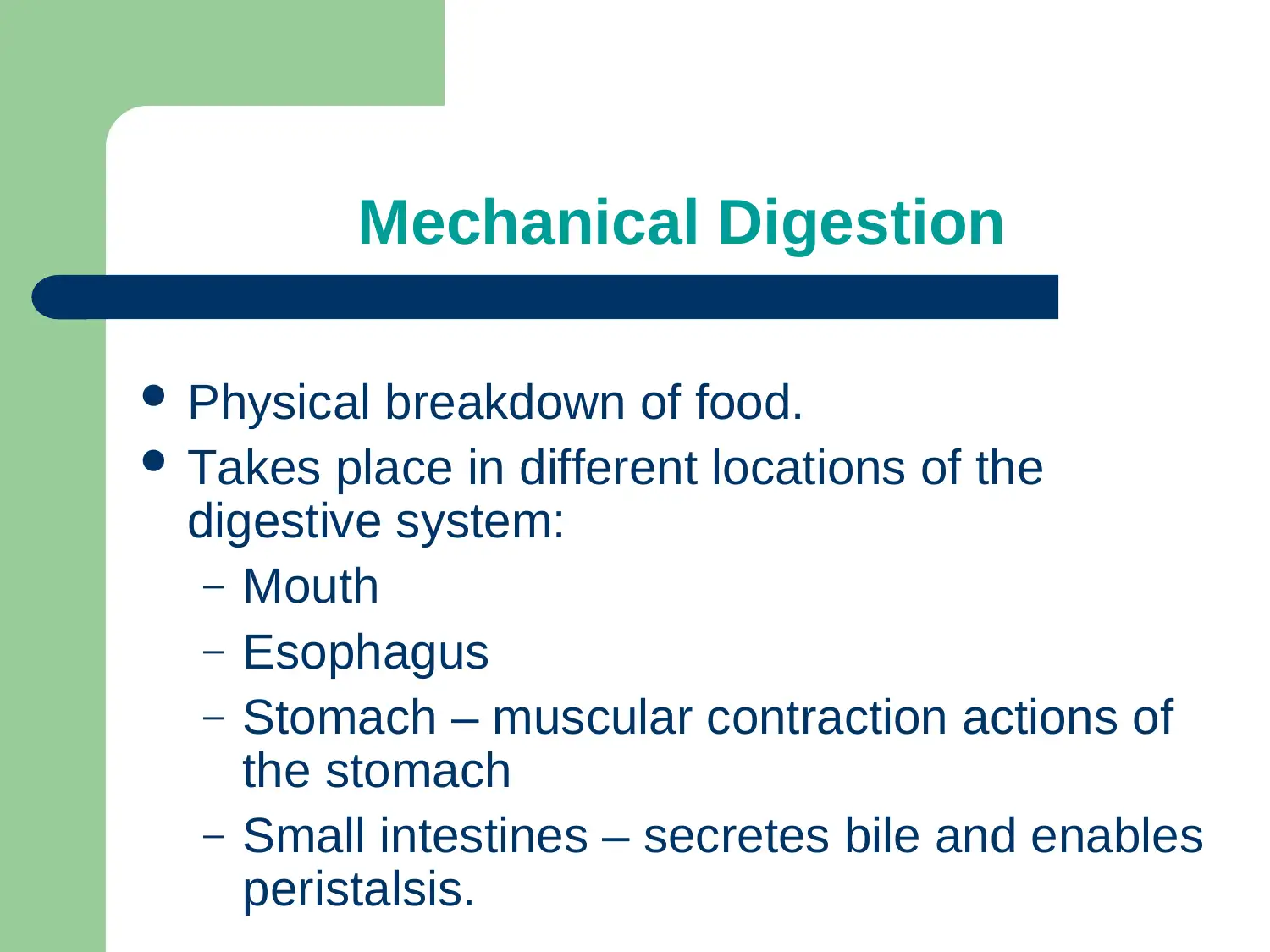
Mechanical Digestion
Physical breakdown of food.
Takes place in different locations of the
digestive system:
– Mouth
– Esophagus
– Stomach – muscular contraction actions of
the stomach
– Small intestines – secretes bile and enables
peristalsis.
Physical breakdown of food.
Takes place in different locations of the
digestive system:
– Mouth
– Esophagus
– Stomach – muscular contraction actions of
the stomach
– Small intestines – secretes bile and enables
peristalsis.
Paraphrase This Document
Need a fresh take? Get an instant paraphrase of this document with our AI Paraphraser
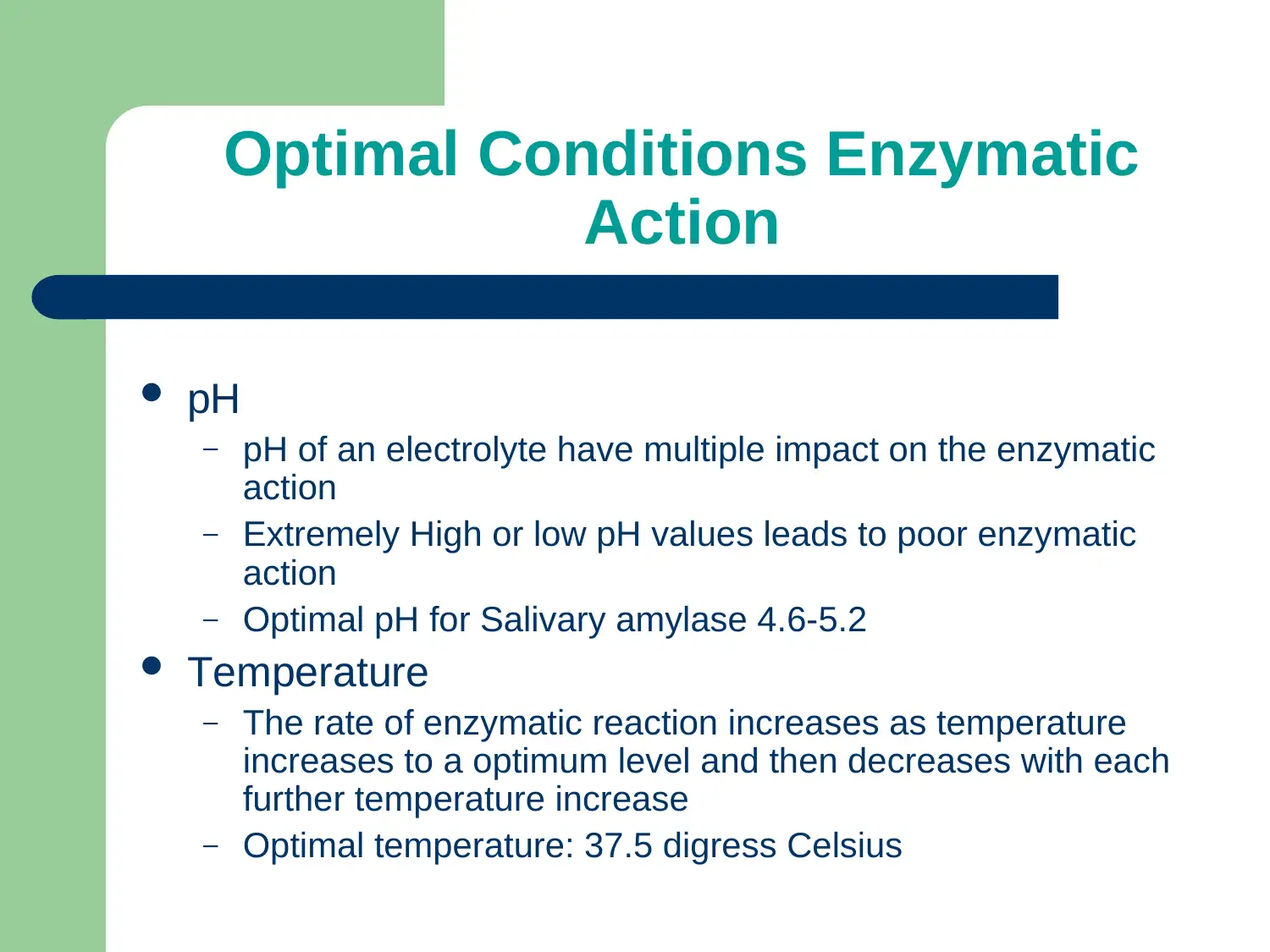
Optimal Conditions Enzymatic
Action
pH
– pH of an electrolyte have multiple impact on the enzymatic
action
– Extremely High or low pH values leads to poor enzymatic
action
– Optimal pH for Salivary amylase 4.6-5.2
Temperature
– The rate of enzymatic reaction increases as temperature
increases to a optimum level and then decreases with each
further temperature increase
– Optimal temperature: 37.5 digress Celsius
Action
pH
– pH of an electrolyte have multiple impact on the enzymatic
action
– Extremely High or low pH values leads to poor enzymatic
action
– Optimal pH for Salivary amylase 4.6-5.2
Temperature
– The rate of enzymatic reaction increases as temperature
increases to a optimum level and then decreases with each
further temperature increase
– Optimal temperature: 37.5 digress Celsius
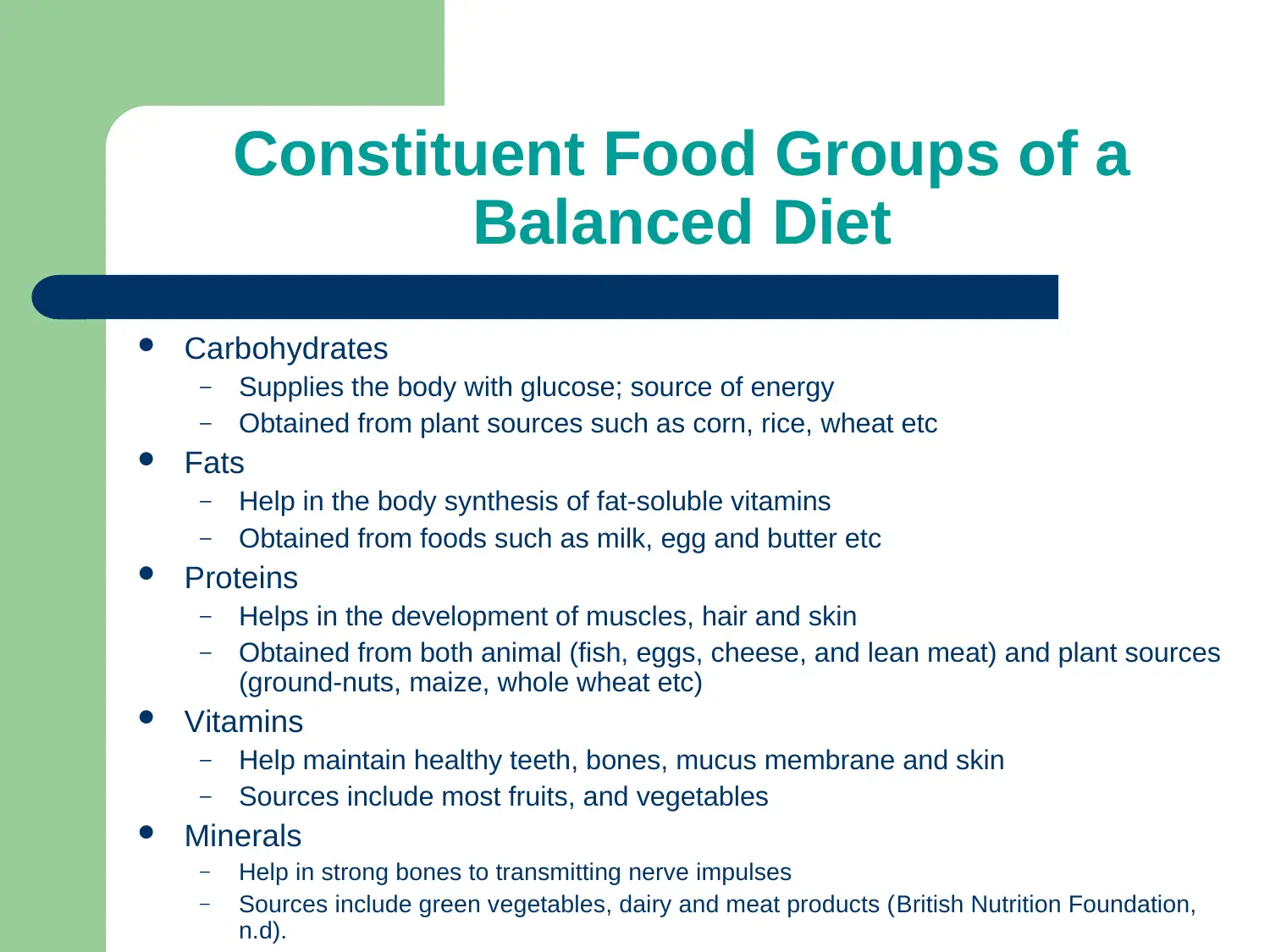
Constituent Food Groups of a
Balanced Diet
Carbohydrates
– Supplies the body with glucose; source of energy
– Obtained from plant sources such as corn, rice, wheat etc
Fats
– Help in the body synthesis of fat-soluble vitamins
– Obtained from foods such as milk, egg and butter etc
Proteins
– Helps in the development of muscles, hair and skin
– Obtained from both animal (fish, eggs, cheese, and lean meat) and plant sources
(ground-nuts, maize, whole wheat etc)
Vitamins
– Help maintain healthy teeth, bones, mucus membrane and skin
– Sources include most fruits, and vegetables
Minerals
– Help in strong bones to transmitting nerve impulses
– Sources include green vegetables, dairy and meat products (British Nutrition Foundation,
n.d).
Balanced Diet
Carbohydrates
– Supplies the body with glucose; source of energy
– Obtained from plant sources such as corn, rice, wheat etc
Fats
– Help in the body synthesis of fat-soluble vitamins
– Obtained from foods such as milk, egg and butter etc
Proteins
– Helps in the development of muscles, hair and skin
– Obtained from both animal (fish, eggs, cheese, and lean meat) and plant sources
(ground-nuts, maize, whole wheat etc)
Vitamins
– Help maintain healthy teeth, bones, mucus membrane and skin
– Sources include most fruits, and vegetables
Minerals
– Help in strong bones to transmitting nerve impulses
– Sources include green vegetables, dairy and meat products (British Nutrition Foundation,
n.d).
⊘ This is a preview!⊘
Do you want full access?
Subscribe today to unlock all pages.

Trusted by 1+ million students worldwide
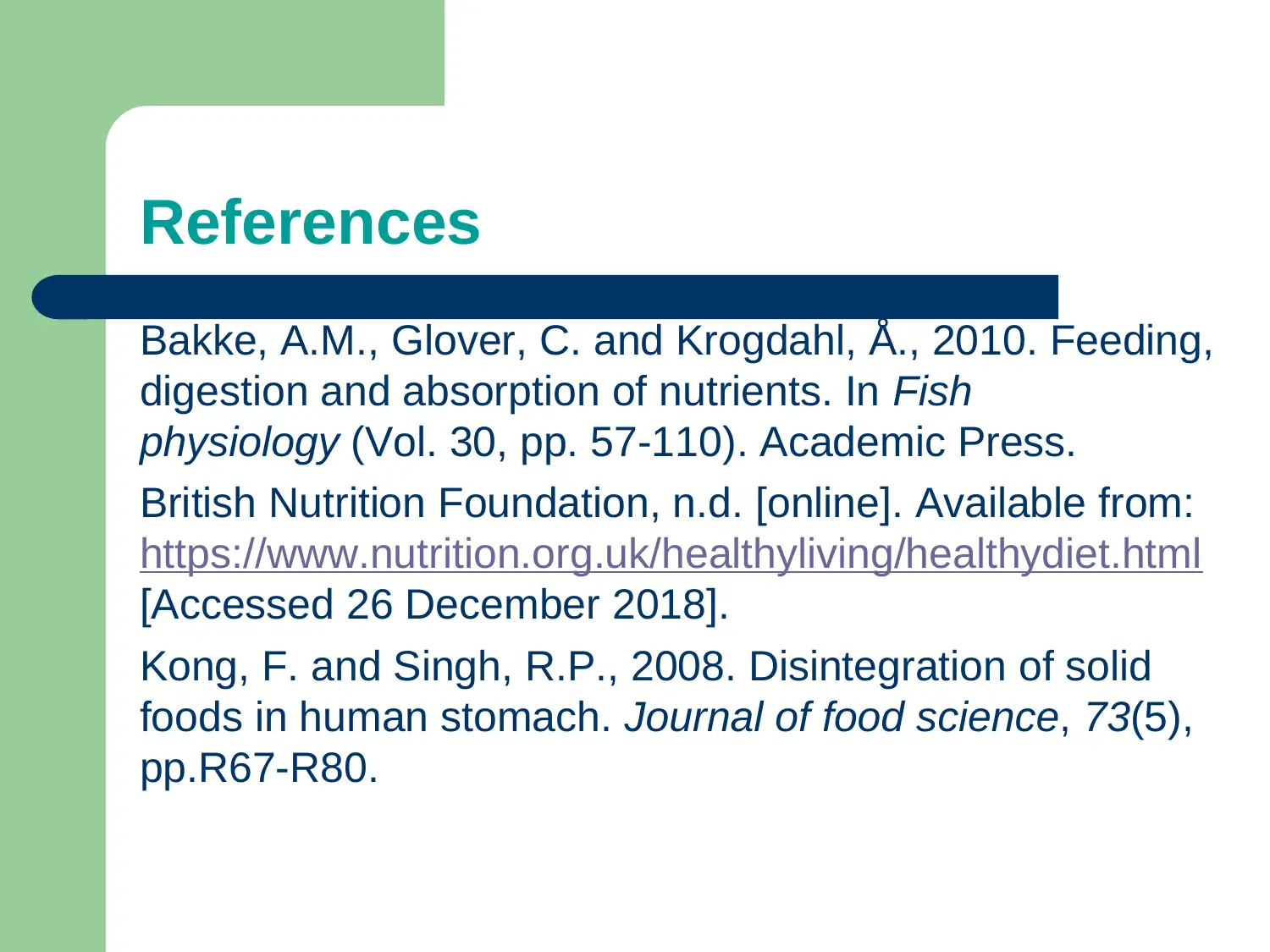
References
Bakke, A.M., Glover, C. and Krogdahl, Å., 2010. Feeding,
digestion and absorption of nutrients. In Fish
physiology (Vol. 30, pp. 57-110). Academic Press.
British Nutrition Foundation, n.d. [online]. Available from:
https://www.nutrition.org.uk/healthyliving/healthydiet.html
[Accessed 26 December 2018].
Kong, F. and Singh, R.P., 2008. Disintegration of solid
foods in human stomach. Journal of food science, 73(5),
pp.R67-R80.
Bakke, A.M., Glover, C. and Krogdahl, Å., 2010. Feeding,
digestion and absorption of nutrients. In Fish
physiology (Vol. 30, pp. 57-110). Academic Press.
British Nutrition Foundation, n.d. [online]. Available from:
https://www.nutrition.org.uk/healthyliving/healthydiet.html
[Accessed 26 December 2018].
Kong, F. and Singh, R.P., 2008. Disintegration of solid
foods in human stomach. Journal of food science, 73(5),
pp.R67-R80.
1 out of 10
Related Documents
Your All-in-One AI-Powered Toolkit for Academic Success.
+13062052269
info@desklib.com
Available 24*7 on WhatsApp / Email
![[object Object]](/_next/static/media/star-bottom.7253800d.svg)
Unlock your academic potential
Copyright © 2020–2026 A2Z Services. All Rights Reserved. Developed and managed by ZUCOL.





